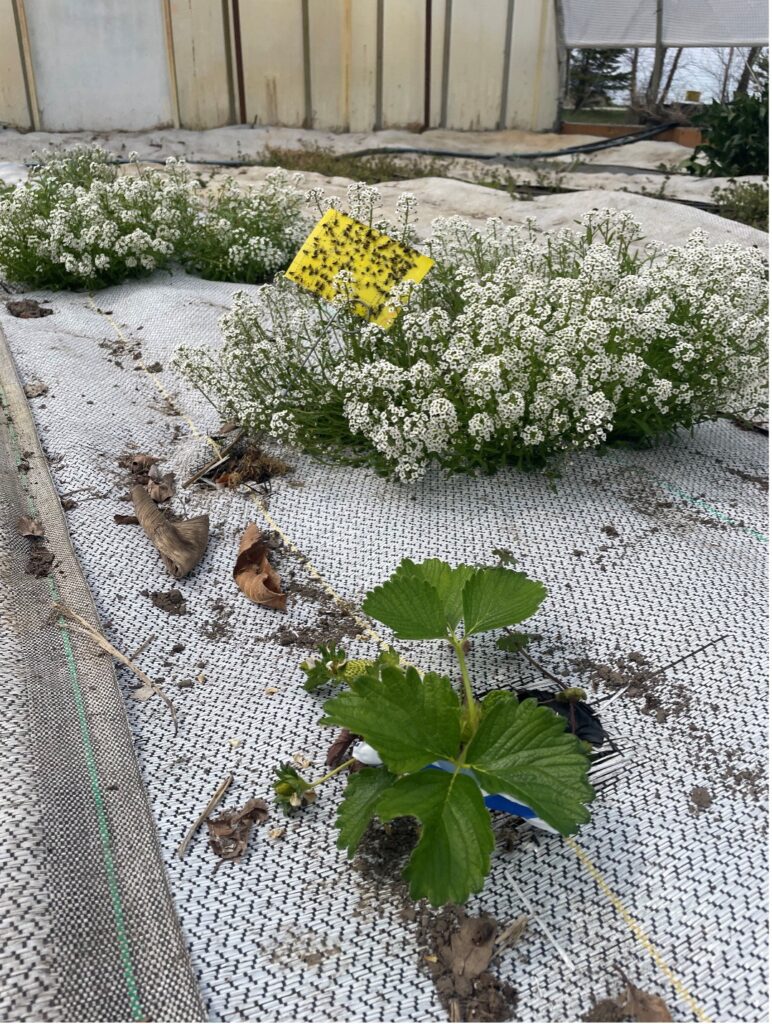Spring is in full swing in our research high tunnels at Purdue. Overwintering strawberries that we planted in September are now in full bloom and fruits are being harvested. But as temperatures increase and crops become more productive, we also see the emergence of various insect pests. Aphids, amongst other soft-bodied insect pests (e.g., whiteflies, mites, and thrips), are the primary culprit on the strawberries and spinach we grow in the high tunnels. The damage caused by these pests can lead to significant yield losses that may offset the economic benefits of growing food for early-season markets. Luckily, as these pests emerge, so do their natural enemies – predacious arthropods and parasitoid wasps! Promoting these insects in high tunnels can provide natural and targeted pest suppression services, thus eliminating the need for chemical sprays or augmentative biological control and reducing crop damage overall. The question becomes, how do we promote these organisms in our high tunnels?
One way is to incorporate insectary plants, like sweet alyssum. Sweet alyssum is a plant in the mustard family (Brassicaceae) characterized by its small white flowers and its pungent, sweet aroma (Figure 1). It is considered an insectary plant because its aroma is alluring to a variety of beneficial insects. Predators and parasitoids depend on their prey as a source of protein, but require carbohydrates in the form of plant nectar to fuel them as they search for their next victim. The smell of sweet alyssum flowers tells these insects that there is plenty of nectar to be had. In our research tunnels, we planted sweet alyssum in half of our high tunnels (Figure 2) and observed a very promising phenomenon. Strawberries planted alongside sweet alyssum had almost no aphids on them; meanwhile, strawberries planted alone had higher aphid pressure. While we can’t definitively tie the reduced aphid abundance to the sweet alyssum, sticky card traps that we deployed have shown that parasitoid wasps and syrphid flies (Figure 3) are in increased abundance where sweet alyssum is present. These insects are likely driving the reduction in aphid pressure.
In addition to pest suppression, the sweet alyssum may indirectly increase fruit set in strawberries by increasing the number of pollinators present. This early in the year, bees are only beginning to emerge and are less inclined to enter high tunnels compared to other insects. However, our sticky card traps have shown us that sweet alyssum draws in many types of flies. Flies aren’t the typical image you think of when considering pollinators, but they are, in fact, the second most important pollinators behind bees (Figure 4). Flies are especially important pollinators of strawberries. For early-season fruit production in high tunnels, flies are likely doing the bulk of the pollination. Planting sweet alyssum can increase fly abundance in the tunnels, thus theoretically increasing fruit set!

Figure 2. Sweet alyssum grown alongside strawberries in research high tunnels at the Purdue Meigs Horticultural Farm. Notice the yellow sticky card trap with a high abundance of flies and other insects present (Photo by Robert Grosdidier).
We encourage growers to experiment with growing sweet alyssum, as well as other insectary or companion plants, on your own farm! These plantings are a low-cost, low-maintenance method of increasing pest suppression and pollination services. Additionally, they will make your farm a more beautiful, aromatic, and biodiverse system.


